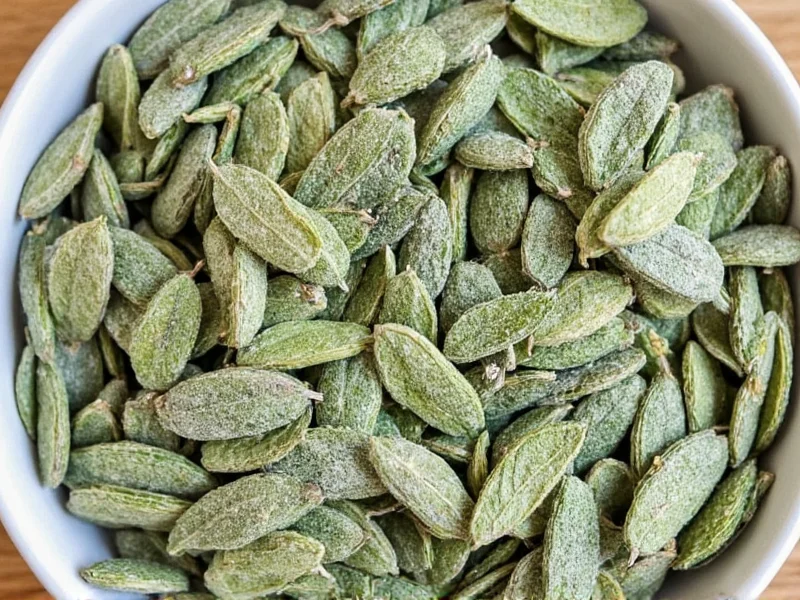Understanding herb conversions is essential for achieving balanced flavors in your cooking. When substituting dried sage for fresh (or vice versa), getting the proportions right can mean the difference between a perfectly seasoned dish and an overpowering culinary mistake.
Why Dried and Fresh Sage Have Different Potencies
During the drying process, sage loses approximately 70-80% of its water content. This concentration effect makes dried sage significantly more potent by volume than its fresh counterpart. The essential oils and flavor compounds become more concentrated as moisture evaporates, which is why you need less dried sage to achieve similar flavor intensity.
This 1:3 ratio isn't unique to sage—it applies to most woody herbs like rosemary, thyme, and oregano. Leafy herbs like basil and cilantro follow a slightly different 1:4 ratio due to their higher water content.
Practical Sage Conversion Guide
| Dried Sage | Fresh Sage Equivalent | Best Used For |
|---|---|---|
| 1/4 teaspoon | 3/4 teaspoon | Delicate sauces, egg dishes |
| 1/2 teaspoon | 1 1/2 teaspoons | Vegetable dishes, light soups |
| 1 teaspoon | 1 tablespoon | Meat rubs, stuffing, hearty stews |
| 1 tablespoon | 3 tablespoons (1/4 cup) | Large batch cooking, holiday recipes |
When to Adjust the Standard Sage Ratio
While the 1:3 ratio serves as an excellent starting point for sage dried to fresh conversion, certain factors may require slight adjustments:
- Recipe cooking time: For dishes that simmer for hours, reduce dried sage by 25% as flavors continue to concentrate during long cooking
- Herb freshness: Older dried sage loses potency—if your dried sage is more than a year old, increase by 1/8 teaspoon
- Dish acidity: In tomato-based or vinegar-heavy recipes, increase dried sage by 10-15% as acidity can mute herbal flavors
- Personal preference: Some palates detect sage's earthy notes more strongly—start with 75% of the recommended amount and adjust to taste
Common Sage Substitution Mistakes
Many home cooks make these critical errors when converting between dried and fresh sage:
- Using equal measurements: Treating dried and fresh sage as interchangeable without conversion leads to overpowering dishes
- Adding dried sage too late: Dried herbs need time to rehydrate and release flavors—add at least 20 minutes before serving
- Not rubbing dried sage: Gently crush dried sage between your fingers before adding to release essential oils
- Substituting in delicate dishes: Dried sage works better in hearty dishes while fresh shines in lighter preparations
Maximizing Sage Flavor in Your Cooking
For the best results with either form of sage:
- Fresh sage preparation: Remove leaves from stems, stack them, then chiffonade (roll and slice) for even distribution
- Dried sage activation: Bloom dried sage in hot oil or broth for 30 seconds before adding other ingredients
- Timing matters: Add fresh sage in the last 5-10 minutes of cooking to preserve its delicate flavor
- Pairing wisdom: Sage complements butter, lemon, garlic, pork, butternut squash, and white beans exceptionally well
Storage Tips for Optimal Freshness
Proper storage extends the usability of both forms:
- Fresh sage: Wrap in slightly damp paper towel, store in airtight container in refrigerator crisper drawer (lasts 1-2 weeks)
- Dried sage: Keep in airtight glass container away from light and heat (maintains potency for 1-2 years)
- Freezing fresh sage: Blanch leaves for 30 seconds, freeze on baking sheet, then transfer to freezer bags (preserves flavor for 6-8 months)
- Reviving dried sage: If dried sage seems weak, place in sealed container with a piece of bread for 24 hours to restore some moisture
Understanding Sage in Culinary Context
Sage's distinctive earthy, slightly peppery flavor with hints of eucalyptus makes it a staple in many culinary traditions. In Italian cooking, fresh sage stars in brown butter sauces for pasta, while dried sage features prominently in American Thanksgiving stuffing. The conversion ratio between dried and fresh sage dried to fresh ratio remains consistent across these applications, though cultural preparations may call for different quantities based on regional taste preferences.
When working with the sage dried to fresh conversion ratio in international recipes, remember that European recipes often specify fresh herbs while American cookbooks frequently use dried—this historical convention stems from differences in herb availability throughout the year in different regions.
Practical Application: Recipe Conversion Example
Consider a traditional sausage stuffing recipe that calls for 3 tablespoons of fresh sage:
- Direct conversion: 3 tablespoons fresh = 1 tablespoon dried sage
- For extended cooking: If the stuffing will bake for 45+ minutes, use 2 1/4 teaspoons dried sage instead of the full tablespoon
- For enhanced flavor: Bloom the dried sage in 2 tablespoons of melted butter for 30 seconds before mixing with other ingredients
This approach to sage measurement conversion for recipes ensures the herb complements rather than dominates your dish. Remember that the dried sage equivalent to fresh sage isn't merely a mathematical conversion—it's about understanding how the flavor profile changes with dehydration and adjusting your technique accordingly.











 浙公网安备
33010002000092号
浙公网安备
33010002000092号 浙B2-20120091-4
浙B2-20120091-4